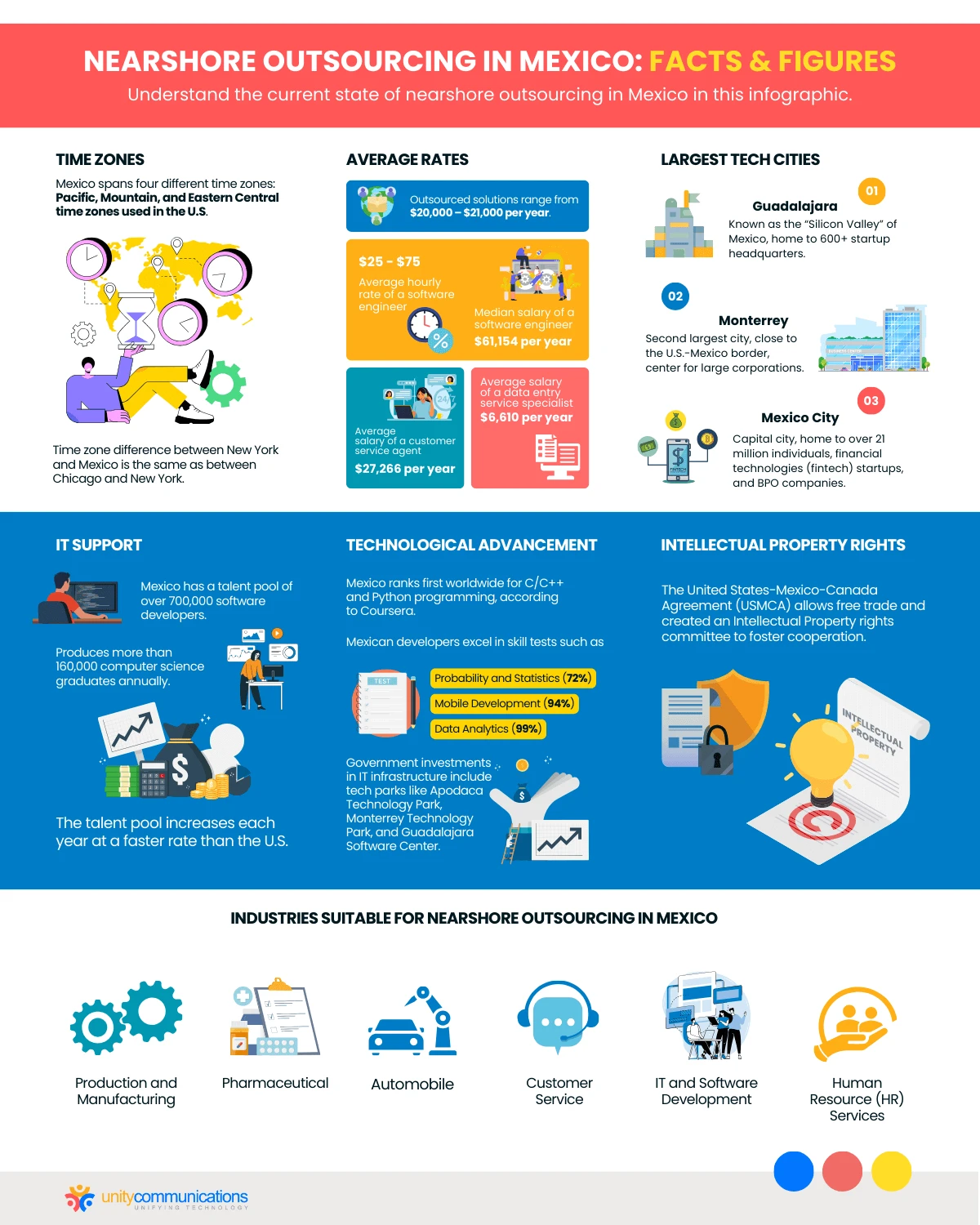Table of Contents
Do you need to hire virtual assistants from Mexico but are scared to employ a service provider away from your home country to perform your task? Fortunately, you can look at different nearshore outsourcing examples in Mexico to help you decide.
This article explores nearshore outsourcing success stories and examples. It tells you about the future of nearshoring and the potential challenges to expect when engaging in the practice. It also shares tips for success.
Mexico Nearshore Outsourcing Examples and Success Stories

First, let’s start with the basics. What is business process outsourcing (BPO)? BPO involves hiring a third party to manage an area of the business process based on pre-agreed metrics.
Nearshoring is a closer-to-home version of outsourcing, where client companies hire vendors with similar time zones and closer geographic and cultural proximity. For example, an American company outsources data entry to Mexico.
Let us examine a few examples of nearshore outsourcing in Mexico that were successful.
Speck’s Significant Cost Savings on Packaging Materials and Air Freight
Speck Products is a market leader in the electronic accessory sector, designing and selling unique products for different personalities. Founded in 2001, they focused on design, lifestyle, and innovation, making the brand a one-stop shop for iPhone, iPod, smartphone, and laptop accessories. They believe that cases should be durable and reflect each customer’s taste.
Speck started finding ways to reduce costs while maximizing production flexibility in 2019. Its detailed shipment cost analysis revealed that building a final retail packaging facility in Mexico provides significant cost-saving opportunities and adds value. It could massively decrease lead times and air freight costs by shipping phone cases in bulk to Mexico.
After determining that Tijuana, Mexico, is the best location to improve operations, Speck sought a reliable nearshore partner to guarantee a smooth transition. The selected partner helped Speck get up and running in just eight weeks. The lower freight cost alone led the phone case brand to achieve considerable cost savings per unit.
Speck thrived by relying on the expertise of its Mexican manufacturing partner, empowering in-house management to focus on what they do best. This nearshore outsourcing success story is only one example that proves the country’s low-cost but high-quality solutions and dedication to service.
Boeing’s Efficient Aerospace Manufacturing
Boeing is a renowned aerospace company known for its excellent design and manufacturing of airplanes. In addition to aircraft, the company also makes missiles, rockets, satellites, and telecommunications equipment.
Boeing first outsourced wiring to Safran, a French multinational company whose operations extend to Mexico and have a 25-year presence there. In 1996, Safran helped Boeing establish the first aerospace manufacturing plant in Mexico.
The plant has four production units, an engineering center, and a wiring system design. It manufactures 75% of the wiring on the Airbus 1380, the world’s biggest jetliner. It also designs and creates 95% of the wiring on the Boeing 787 Dreamliner.
The aerospace company announced in 2020 that it would open a new site in Chihuahua to manufacture the interior of Boeing’s passenger aircraft. Boeing’s success story proves to be an excellent example of nearshore outsourcing.
Whirlpool’s Stronger Supply Chain After Outsourcing
Whirlpool is a leading furniture company and popular home appliance brand worldwide. In 1987, the company outsourced many of its marketing and manufacturing operations to Mexico. The company’s Mexican plant exports 80% of its appliances to the United States and Canada, including washing machines, fridges, and stoves.
Other home appliance brands, such as LG and Samsung, quickly followed Whirlpool’s strategy. Mexico’s BPO industry is known for its robust capabilities, geographic proximity to U.S. markets, and strong supply chain.
This nearshore outsourcing example shows how partnering with an external provider allows companies like Whirlpool to enjoy lower costs and efficiency. Whirlpool reported a record performance year in 2021 with 13% revenue growth.
Industries Suitable for Nearshore Outsourcing in Mexico

Many countries have started making their names in the back-office outsourcing market. Mexico is among the destinations where companies outsource. Here are the commonly outsourced industries in Mexico:
- Production and Manufacturing. Mexico is a great nearshore manufacturing destination. Its manufacturing sites are more beneficial to those considering transportation and productivity costs. It is closer to the U.S. and Canada than China, so fewer products are committed to inventory and held in finished form.
- Pharmaceutical. Some pharmaceutical companies have nearshore manufacturing processes because of the higher production expenditure in the U.S. One nearshore outsourcing example is when Medtronic transferred its plant to Mexico. Cardinal Health, Welch Allyn, Gambro, and Avail also outsource to Mexico.
- Automobile. Nearshoring automobiles involves contracting the manufacturing of certain car parts. One automobile nearshore outsourcing example is when Henry Ford outsourced to Mexico in 1925. Other leading car brands such as GM, Volkswagen, and Nissan followed him in outsourcing to Mexico.
- Customer Service. Mexico benefits from having 130 million bilingual speakers, the biggest in Latin America. Similar cultural aspects and closer time zones also strengthen connections between U.S. end customers and Mexican agents. Nearshore outsourcing examples show that wages and overhead expenses are 50% lower than rates at home.
- IT and Software Development. Mexico has a robust inventive startup community and a wide pool of highly educated developers, ranking second worldwide in skill tests. In 2020, the Mexican software market had a total revenue of $5.4 billion. The talent shortage in the U.S. also makes Mexico a more attractive outsourcing destination.
- Human Resource (HR) Services. Nearshoring HR services to Mexico minimizes costs and eases the administrative burden of recruitment. Since remote work is more common now than ever, companies in the U.S. can hire talent in Mexico with the help of outsourcing vendors who have in-depth knowledge about their local hiring processes.
Current State of Nearshore Outsourcing in Mexico

Now that you have real-life nearshore outsourcing examples let us explore the current state of Mexico’s BPO industry. It might surprise some, but recently, Mexico has become a major IT hub. Mexican BPO companies and workers tackle anything, whether software development or technical support outsourcing.
The country’s government built 38 IT clusters nationwide with high-quality electricity connections, reliable internet, and cutting-edge technology. Some details provide perspective on the country’s nearshore outsourcing industry.
Time Zones
- The time zone in Mexico is not significantly different from that of the U.S., which enables easier collaboration than offshore destinations.
- The country spans four different time zones that match the Pacific, Mountain, and Eastern Central time zones used in the U.S.
- The time zone difference between New York and Mexico is the same as between Chicago and New York.
Average Rate
- The rate of outsourced solutions ranges from $20,000 – $21,000 per year.
- The average hourly rate of a software engineer in Mexico is $25 and $75. The median salary is $61,154.
- The average salary of a customer service agent is $27,266 per year.
- The average salary of a data entry service specialist is $6,610 per year.
Largest Tech Cities
- Guadalajara, known as the “Silicon Valley” of Mexico, is the biggest tech city in the country. Foxconn, HP, Intel, and Mexico all have manufacturing sites in Guadalajara. Currently, the city is home to more than 600 startup headquarters.
- Monterrey, Mexico’s most “American” city, is the second largest. It is in the outskirts, situated close to the U.S.-Mexico border. The city houses a center for large corporations such as FEMSA, Cemex, and Coca-Cola.
- The third largest is Mexico City, the country’s capital. It is home to over 21 million individuals and many financial technologies (fintech) startups and BPO companies.
Talent Pool Size
- Mexico has one of the biggest talent pools for software development, with over 700,000 developers.
- It produces more than 160,000 computer science graduates each year.
- Its talent pool increases each year at a faster rate than the U.S.
Technological Advancement
- According to Coursera, Mexico ranks first worldwide for C/C++ and Python programming.
- Mexican developers rank high in skill tests such as probability and statistics (72%), mobile development (94%), and data analytics (99%).
- The government has also invested in the advancement of its IT offerings. They opened tech parks with large offices and facilities, including:
- Apodaca Technology Park,
- Monterrey Technology Park, and
- Guadalajara Software Center.
Intellectual Property Rights
- The former North American Free Trade Agreement (NAFTA) was revised as the United States-Mexico-Canada Agreement (USMCA), intended to welcome more collaborative environments between the three countries.
- The USMCA allows free trade between the three countries.
- It also created an Intellectual Property rights committee to determine opportunities to increase cooperation.
Future of Nearshore Outsourcing in Mexico

According to Bloomberg, 80% of North American companies are considering nearshore outsourcing to leverage cost-effective solutions and closer geographical proximity. Reports from Clutch show that 21% of small businesses that outsource work plan to hire a nearshore company, an increase from 15% in the previous year.
With the market overview in mind, let us look at changes that will occur in Mexico’s nearshore outsourcing industry.
Higher Demand for Nearshoring Services
Nearshore outsourcing is a popular option for businesses as it offers many benefits, including skilled labor access, proximity to major markets, and significant cost savings. According to Deloitte’s Global Outsourcing Survey, 87% of businesses consider nearshore outsourcing to cut costs, which is one of the drivers for its growing demand.
The Mexican government also invests significantly in nearshoring infrastructure, making the country an attractive BPO destination. With Mexico’s highly skilled workforce and affordable solutions, it will become one of the leading providers of nearshore outsourcing services.
Better Software Development Ecosystem
Mexico will likely refine its software development ecosystem with the rising demand for nearshoring solutions. Strengthening technology includes a range of investments in various initiatives, such as training opportunities for local talent and new infrastructure.
The government also aims to attract foreign entrepreneurs and investors to build other innovative tech products in the country. Mexico’s initiatives will positively influence its IT industry, creating more jobs and increasing investments.
Enhanced Technological Expertise
Mexico houses some of the most talented workers in the world, especially in software development, which will only grow stronger in the coming years. The government’s investment in technological infrastructure and increased access to training opportunities will drive this trend, allowing Mexicans to access cutting-edge innovations that help improve service offerings.
As the country continues to invest in its nearshore outsourcing infrastructure and trains more talent, BPO companies in the country will be able to provide a wider range of specialized services. BPO companies become more competitive and gain better positioning to win contracts with foreign clients by concentrating on providing niche services.
Optimized Outsourcing Processes
The country will continue to improve its nearshore outsourcing practices, providing more cost-effective and transparent solutions to clients who want to offload non-core projects. The government has already stepped in this direction by introducing a code of ethics and other measures to protect intellectual rights.
Mexico’s measures will improve the quality of nearshore outsourcing solutions, fortifying its position in the BPO market and attracting more businesses that aim to reduce costs and access talent.
Potential Challenges of Nearshore Outsourcing in Mexico
Nearshore outsourcing in Mexico has many benefits but also has certain challenges. Let us look at the potential issues you might encounter and how to prevent them.
Difficult Learning Curve for Mexican Regulations
Businesses must ensure compliance with various operational regulations. The USMCA introduced measures that standardized laws, making trade easier. However, companies in the U.S. must familiarize themselves with manufacturing compliance regulations unique to Mexico, which include:
- Normas Oficiales Mexicanas (NOMs) or Official Mexican Standards
- Industria Manufacturera Maquiladora y de Servicio de Exportatción (IMMEX) or Tax incentives for manufacturing companies
- Normas Mexicanas (NMXs) or Voluntary Mexican Standard
Possible Procurement and Supply Chain Concerns
Procurement issues lead to supply chain delays, which affect operations. Disruption in the supply chain results in losses that negate the cost savings of nearshore outsourcing. Hence, companies must address supply chain problems early on.
Businesses often establish designated procurement teams to communicate directly with nearshore manufacturers. Doing so helps them prevent sourcing issues and maximize the benefits of nearshore outsourcing. Companies can reduce manufacturing costs by involving procurement and manufacturing teams.
Noticeable Cultural Differences
Language barriers and cultural differences are common when outsourcing to another country, especially since Mexico ranks 92nd out of 112 English-proficient countries. Failure to manage language and cultural barriers can be fatal to nearshore outsourcing efforts.
Although Americans and Mexicans can understand each other better than offshore BPO destinations, companies should proactively find cultural mediators to prevent conflict. Partnering with a qualified and reliable BPO partner who understands your organizational and local culture is important to bridge gaps between in-house and third-party teams.
Uncertain Investment Costs
You need to understand how much it will cost you to outsource. Some of the costs involved are service fees, training expenses, logistics, taxes, and fiscal obligations on the state and federal levels. Understanding different BPO pricing models is important to determine what works best.
The goal behind nearshore outsourcing is to save costs and increase profit margins. The whole engagement is futile if you are unable to achieve this goal. Detailed cost analysis and financial planning are necessary before nearshoring to understand the cost and make an informed decision. Also, consider consulting a BPO company in Mexico to better estimate costs.
Daily Management Problems
Companies must collaborate remotely with their nearshore teams in Mexico. If done poorly, remote collaboration leads to miscommunication and disagreements, weighing down productivity over time.
The best way to solve administrative problems with nearshore outsourcing is to use a platform for task management, productivity tracking, and daily communication. A performance management tool monitors workers’ productive and idle time and generates detailed reports. It also helps in tracking shifts and schedules.
Tips for Successful Nearshore Outsourcing in Mexico

Despite the many successful examples of nearshore outsourcing, it can be a daunting strategy to adopt, especially for beginners. However, careful planning ensures that your nearshoring experience goes smoothly.
Below, we provide different tips for different nearshore outsourcing stages. Whether you want to acquire a contact center as a service (CCaaS) solution or outsource manufacturing, you can find something worth considering.
Before the Agreement
- Ensure that the nearshore partner can deliver requested solutions and products.
- Check reviews from previous and current clients.
- Verify your prospect’s track record and experience.
- Draft a non-disclosure agreement (NDA) to freely provide sufficient specifications. This allows free discussion of the project’s scope, required team, and start and end date.
- Examine potential risks.
- Perform a cost-benefit analysis and compare prices from different vendors.
When Choosing an Engagement Model
- Discuss with your BPO provider the most suitable engagement model for you.
- Consider a team extension model when you need an additional workforce and simply want to engage a few staff members to join.
- Use a cross-functional team or outsource a function completely when you cannot handle the job in-house cost-effectively.
During the Collaboration
- Set an initial meeting with the nearshore team and prepare well for it, as it serves as a workshop. This is where you introduce team members, discuss goals and project roadmaps, define roles, and establish communication rules and status reporting.
- Perform a knowledge transfer to help the nearshore team understand your business and get acquainted with your way of working. Knowledge transfers often take a few days to a few weeks.
- Keep communication lines open. Communication is key to the success or failure of your outsourced project.
- Avoid an ‘us’ vs. ‘them’ thinking pattern to achieve success in the collaboration. Respect each other and treat the nearshore team like your in-house staff.
- Allow the nearshore team to express feedback and make suggestions for improvements. They will be happy to see that you value their feedback, leading to increased motivation and commitment.
- Conduct periodic performance review meetings to plan improvements, discuss future undertakings, and exchange feedback.
The Bottom Line

To sum up, nearshore outsourcing offers many benefits that will unlock your business potential, provided that you plan well, understand possible risks and ways to mitigate them, and stay committed to achieving success. The real-life nearshore outsourcing examples here show that companies across different sizes and industries have much to gain by contracting out work.
Communication is vital with nearshore outsourcing. Do not go weeks without contacting your BPO provider. Set up regular virtual meetings to foster a better understanding, stronger working relationships, and greater results.




